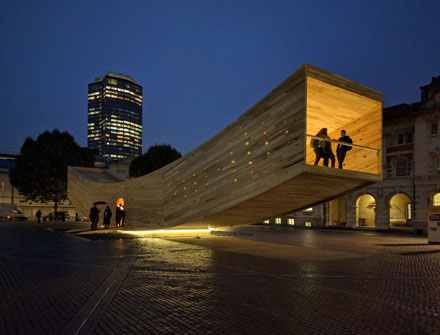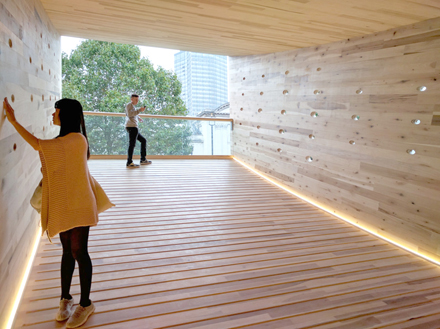
Visitors to the London Design Festival can experience an unusual curved wooden building called The Smile. Source: Inhabitat
Designed by Alison Brooks of Alison Brooks Architects, the sloping structure demonstrates the potential of CLT, which Brooks says is “stronger than concrete.”
The timber utilized in The Smile is American tulipwood. Usually CLT is made of spruce, but engineering and design firm Arup is experimenting with tulipwood as it is stronger than spruce and affords a more elegant appearance.
Tulipwood CLT is also sustainable, according the European Director of the American Hardwood Export Council David Venables, because it is abundant and because CLT utilizes low-grade timber that’s not exported for furniture making anymore, therefore using more of what is harvested.
Twelve tulipwood CLT panels comprise The Smile. Each is around 14 meters long and 4.5 meters wide, or around 46 feet long and 15 feet wide.
Yet with a thickness of just 100 milimeters, or close to four inches, most of the floor and wall panels are quite thin.
Oval holes in The Smile allow sunlight to permeate the space.
The interactive installation is meant to draw the curious. Alison Brooks said in a statement.
The Smile’s form implies that it will rock. So the form itself is an invitation to test whether the pavilion moves, and how it feels to walk in on a curved floor.
A single door and ramp from the square invites visitors to enter – something like our archetypal image of Noah’s Ark. Inside the door light spilling from the ends of the arc will invite you to walk up the slope of the curve to balconies at either end, rather like looking out from the rail of a ship.
The Smile was created out of a collaboration between the London Design Festival, Alison Brooks Architects, the American Hardwood Export Council, and Arup.
It will be on display between September 17 and October 12, 2016 at the Chelsea College of Art Rootstein Hopkins Parade Ground.





